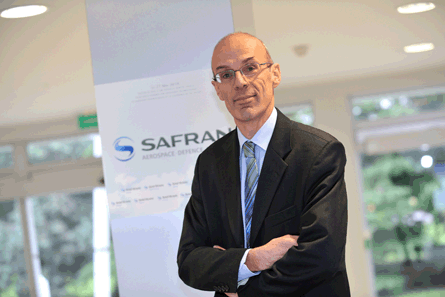Lean is beyond the realm of buzzword for nacelle provider Aircelle. One year after implementing a company-wide initiative, the Safran subsidiary has cut its assembly time for Airbus A380 nacelles from 100 days to 30 days. The company provides the nacelles for both engine providers, Rolls-Royce and Engine Alliance, including the electrically actuated thrust reversers on the two inboard engines (the A380 does not have reversers on the outboard engines).
It is not just the production floor where the effort is paying off however. Aircelle chairman and chief executive Vincent Mascré says lean is being applied to human resources, finance, sales and marketing and managers in general. At the upper levels, he says meeting times have been reduced from 2h length average to 1.5h, with the eventual goal being a 30% cut in the number of meetings as well.
 |
|---|
© Vincent Mascre |
Efficiency will be key going forward as the $1 billion revenue company ramps its 2010 output 30% by 2015. That means jumping from 110 airline customers to 140; seeing an increase of flight time on its nacelles from 260 million to 435 million hours a year, and the number of equipped engines ramping from 13,200 to 16,800.
Along with producing its most advanced nacelles to date for the A380, Aircelle builds nacelles and/or thrust reversers for a variety of Airbus products, business jets and regional jets, including two nacelles a month for the Sukhoi Superjet 100.
The company is building the nacelle for the new Bombardier Global 7000 and Global 8000 (through Nexcelle) as well as the all-composite Learjet 85, following up on the success of the nacelle for Bombardier Challenger 300, which features Honeywell HTF7000 turbofan engines. Other nacelles for business jet platforms include the Pratt &Whitney Canada PW307-powered Dassault 7X and Airbus A318 with PW6000 engines.
For the legacy A320 line, Aircelle currently builds 480 thrust reverser systems each year for the A319, A320 and A321. Other platforms include the A330, A340-500/600 and Embraer 170.
Mascré says Airbus has asked Aircelle to bid nacelles for both engine offerings on the A320neo re-engining programme, although the airframer ultimately selected Aircelle competitor Goodrich for the Pratt & Whitney PW1100G geared turbofan offering. Aircelle was selected for nacelles for the CFM International Leap-X option, for which first customers are to be announced in Paris this week. Mascré notes that the P&W nacelle is more complicated than the CFM design due to P&W's variable area nozzle feature, which must be coupled into the engine's FADEC.
"In the Neo, Airbus insisted on steep ramp-up in 2016 to very quickly replace the existing A320 line," says Mascré . "They wanted absolute reliability, a very smooth ramp-up, and wanted to keep airframe itself almost the same." As such, the company designed a nacelle with traditional "C" duct hydraulically actuated thrust reversers.
With the Comac C919, which Aircelle won in a joint venture with GE's Middle River Aircraft Systems (called Nexcelle), the integrated propulsion systems uses the most advanced systems, including electric thrust reversers from the A380 design, electric anti-icing for the inlet and a one-piece, low maintenance "O" duct thrust reverser.
Future programmes are likely to benefit from an "e-Nacelle" research and development programme under way at Aircelle. In addition to a translating inlet that aids in laminar flow improvement (which Mascré says will have a "visible" effect on drag reduction), the programme features distributed adaptive acoustics, increased use of composites and electric. Mascré says the A380 nacelle is 55% composites by weight while the C919 design could be as high as 70%.
Improvements to A380 nacelles are under way courtesy of an Airbus programme to increase the reliability of the superjumbo. For the nacelle, which is maintained as an "on condition" subsystem, Aircelle is planning to introduce next year a non-destructive testing techniques, including tomography, and tools to allow airlines to inspect composite components of the nacelle "to tell you when you need to intervene," Mascré says.
"We've narrowed the field to three or four techniques after a large survey of the all the techniques that would be reliable and easy to practice on line," he says. Adding that the request came from the operators, particularly in Asia due to exposure of the composites to increased humidity. "There's more concern about aging of composites over there," says Mascré, adding that there have not been problems reported with the composites to date.
"We participate in every 'C' check," Mascré says. "We have a few findings, but they're minor. Some are being treated through service bulletins and small design changes. The in-service experience has been good, with very few snags." He notes that the five operators now flying the A380 "are satisfied with the state of the product". Aircelle has 3,000 employees and eight manufacturing, assembly and podding facilities globally.
Through Qantas, Aircelle was able to "perform" some special testing. "We had the opportunity to have a destructive test that all the engineers would have dreamed to have had in the development phase," says Mascré. In the aftermath of the uncontained engine failure on Qantas's A380 in November, Mascré says Aircelle engineers were able to analyse the nacelle in Singapore before it was removed from the aircraft. Ironically, they liked what they saw. "The cowls broke where we expected them to break in a high-energy event," says Mascré. "We proved that the nacelle behaved exactly has we expected it to behave."
- All the latest news, images and video from the 2011 Paris air show
Source: Flight Daily News
















